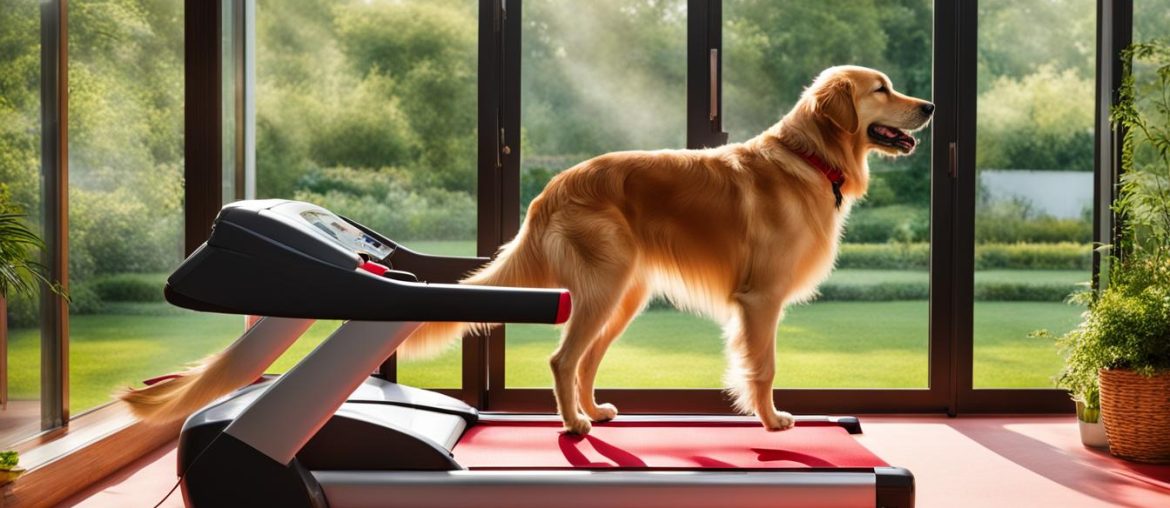Teaching your dog to use a treadmill can be a valuable skill that provides numerous benefits. Whether it’s providing exercise when the weather is bad or aiding in your dog’s rehabilitation after an injury, having them comfortable on a treadmill opens up a world of possibilities. In this section, I will guide you through the process of teaching your dog to use a treadmill, ensuring their safety and enjoyment throughout.
Key Takeaways:
- Dog treadmill training can be beneficial for exercise and rehabilitation purposes.
- Start by creating a positive association with the treadmill, rewarding your dog for getting on and off.
- Gradually introduce the sound of the motor and fan, and slowly increase the speed as your dog becomes more comfortable.
- Always monitor your dog’s comfort level and keep the sessions short and enjoyable.
- Teaching your dog to use a treadmill requires patience, consistency, and positive reinforcement.
The Benefits of Dog Treadmill Exercise
Using a treadmill for your dog’s exercise routine offers a range of benefits. It provides a full-body workout without the impact of outdoor activities, making it ideal for athlete dogs or dogs in rehabilitation. Treadmill exercise can be used to warm up your dog before trick training, dog sports, or long walks. It also serves as a mental workout on days when outdoor activities are limited. Regular treadmill workouts can help improve your dog’s fitness, maintain a healthy weight, and provide mental stimulation.
One of the key advantages of dog treadmill exercise is the controlled environment it offers. With a treadmill, you can adjust the speed, incline, and duration of the workout to suit your dog’s individual needs. This level of control is especially beneficial for dogs recovering from injuries or those with specific health conditions. By gradually increasing the intensity of the exercise, you can safely build your dog’s strength and endurance over time.
Table: Comparing Outdoor Walks and Treadmill Exercise
| Outdoor Walks | Treadmill Exercise | |
|---|---|---|
| Impact on Joints | Varies based on terrain | Low impact, controlled surface |
| Weather Dependence | Yes, limited by weather conditions | No, suitable for all weather |
| Interruptions | Frequent stops for sniffing and exploring | Continuous workout without interruptions |
| Mental Stimulation | Provides sensory experiences and new environments | Focused workout, requires mental engagement |
“Treadmill exercise can be a valuable addition to your dog’s fitness routine, offering controlled and consistent workouts that target both physical and mental well-being.” – Dr. Emily Thompson, veterinarian
While outdoor walks provide opportunities for socialization and exposure to new sights and smells, treadmill exercise can be a convenient alternative when outdoor activities are limited. It allows you to maintain your dog’s exercise routine regardless of the weather or time constraints. However, strike a balance between treadmill exercise and outdoor walks to ensure your dog receives both physical and mental stimulation.
To sum it up, incorporating treadmill exercise into your dog’s routine can provide a variety of benefits, including controlled workouts, improved fitness, and mental stimulation. With proper training and supervision, your dog can safely enjoy the advantages of treadmill exercise, leading to a healthier and happier life.
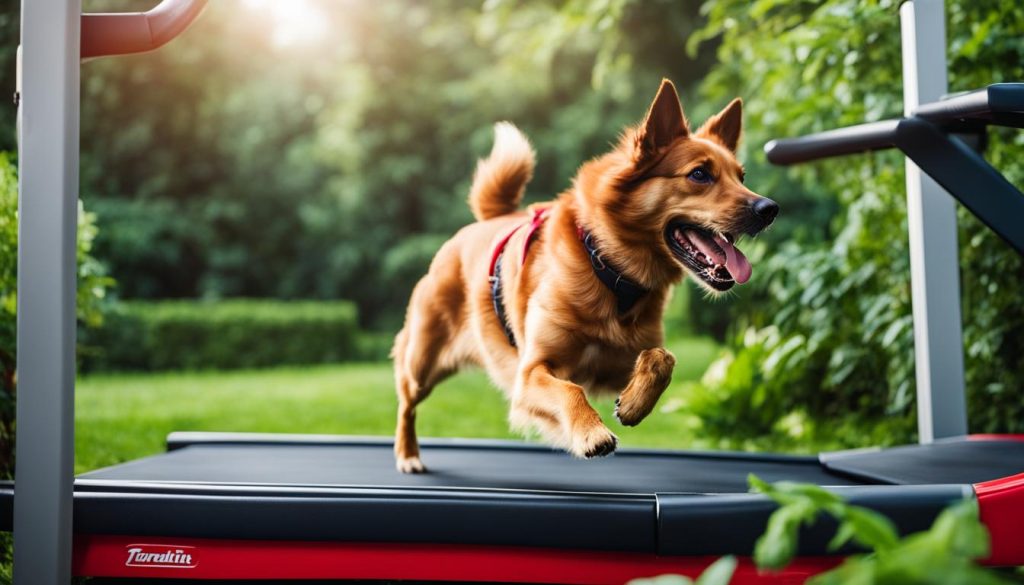
Introducing Your Dog to the Treadmill
To introduce your dog to the treadmill, create a positive association and take gradual steps. Begin by rewarding your dog for simply getting on and off the treadmill, allowing them to explore and become familiar with the equipment. This helps them feel comfortable and builds trust.
Once your dog is comfortable with being on the treadmill, you can start introducing the sound of the motor. Turn it on without starting the motion, and reward your dog for remaining calm and relaxed. This helps them associate the sound with positive experiences.
Next, start the treadmill at a slow speed and encourage your dog to walk on it. Reward them for walking and staying on the treadmill, gradually increasing the speed over time. I recommend that you closely monitor your dog’s comfort level and adjust the speed and duration of the sessions accordingly.
Introducing Your Dog to the Treadmill: Key Tips
- Start with rewards for getting on and off the treadmill
- Gradually introduce the sound of the motor
- Start the treadmill at a slow speed and reward walking on it
- Monitor your dog’s comfort level and progress at their pace
“Introducing your dog to the treadmill requires patience and positive reinforcement. By taking it slow and making it a positive experience, you can help your dog feel comfortable and confident using this exercise equipment.”
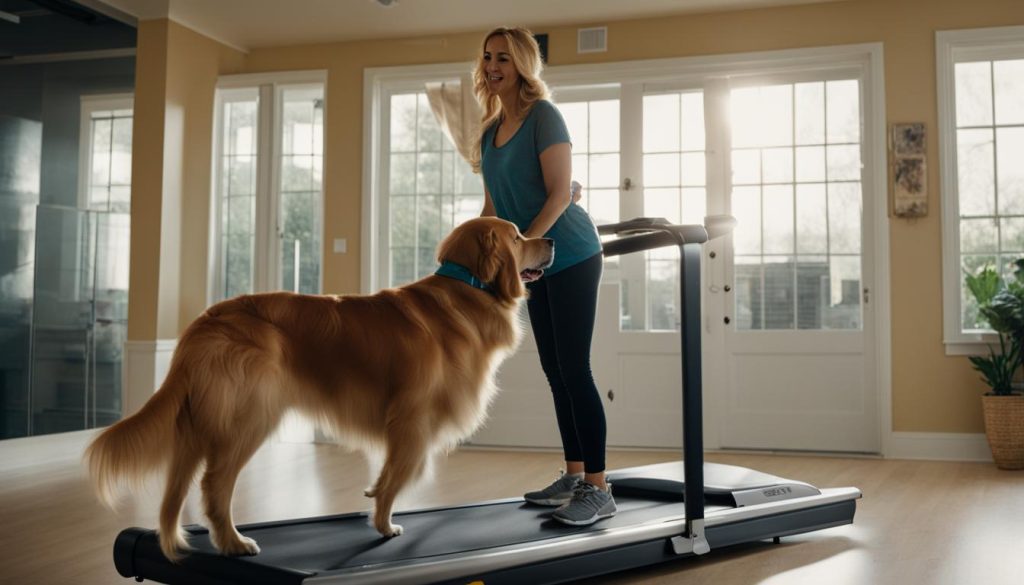
| Benefits of Introducing Your Dog to the Treadmill | Tips for Successful Introduction |
|---|---|
|
|
Training Your Dog on the Treadmill
When it comes to training your dog on a treadmill, approach the process with patience and consistency. By breaking it down into manageable steps and using positive reinforcement, you can help your dog become comfortable and confident using this exercise equipment. Here is a guide to teaching your dog to use a treadmill effectively:
Step 1: Creating a Positive Association
Start by creating a positive association with the treadmill. Begin by rewarding your dog for simply getting on and off the treadmill without the machine being turned on. Use treats, verbal praise, and other rewards to reinforce this behavior. Gradually progress to turning on the motor without starting the motion and continue rewarding your dog for staying on the treadmill. This will help them become familiar with the sounds and movement associated with the equipment.
Step 2: Starting Slow and Rewarding Progress
Once your dog is comfortable with the sound of the motor, it’s time to start the treadmill at a slow speed. Encourage your dog to walk on the treadmill and reward them for doing so. Start with short sessions and gradually increase the duration as your dog becomes more confident. I recommend that you always monitor your dog’s comfort level and ensure that they are enjoying the training process. Try to use positive reinforcement consistently to motivate your dog and make the experience enjoyable for them.
Step 3: Taking It One Step at a Time
Training your dog on the treadmill is a process that takes time and patience. I recommend that you not rush through the steps and to allow your dog to progress at their own pace. Expect to spend a week on each step of the training process, gradually increasing the speed and intensity as your dog becomes more comfortable. Building your dog’s confidence is key, so if they show any signs of distress or discomfort, take a step back and reassess. By taking it one step at a time, you can ensure that your dog develops the necessary skills and confidence to use the treadmill effectively.

| Training Tip | Key Takeaway |
|---|---|
| Consistency is key | Be consistent with your training sessions and rewards to reinforce desired behaviors. |
| Monitor your dog’s comfort level | Always pay attention to your dog’s body language and adjust the speed and duration accordingly. |
| Use positive reinforcement | Reward your dog with treats, praise, and other rewards to motivate them and make the training experience enjoyable. |
| Take breaks | Keep the training sessions short and leave your dog wanting more. This will maintain their interest and enjoyment. |
Safety Guidelines for Dog Treadmill Training
Ensuring the safety of your dog during treadmill training is crucial to prevent any accidents or injuries. To ensure a safe and successful training experience, follow these essential guidelines:
- Never force your dog onto the treadmill: I recommend that you allow your dog to have control over their movements and feel comfortable using the equipment. Forcing them onto the treadmill can create fear and anxiety, making the training process difficult.
- Always supervise your dog: closely monitor your dog during the training sessions, especially in the initial stages. Be prepared to stop the treadmill immediately if any issues or concerns arise.
- Avoid over-exercising: please avoid overworking your dog on the treadmill. Gradually increase the duration and intensity of the workouts to prevent strain or exhaustion. If you’re unsure about the appropriate duration, consult with your veterinarian.
- Use appropriate-sized treadmills: Ensure that the treadmill you use is suitable for your dog’s size and breed. Using a treadmill that is too small or too large can lead to discomfort or potential injuries.
By following these safety guidelines, you can create a safe and positive environment for your dog to learn and enjoy using the treadmill.

Treadmill Safety Tips
In addition to the guidelines mentioned above, here are some extra tips to enhance safety during dog treadmill training:
- Introduce gradual speed increases: Start at a slow pace and gradually increase the speed over time. This allows your dog to adapt to the movement and prevents sudden jerks or jolts.
- Keep distractions to a minimum: Ensure that the training area is free from any distractions that might startle or divert your dog’s attention. This will help them focus on the treadmill and maintain good form.
- Regularly check the treadmill for any hazards: Before each training session, inspect the treadmill for any loose parts or potential hazards. Make sure that the surface is clean and free from any debris that could cause your dog to slip or trip.
- Allow for rest breaks: Just like humans, dogs need rest breaks during exercise. If your dog shows signs of fatigue or discomfort, give them a break and allow them to recover before continuing the training session.
By implementing these safety tips, you can minimize the risks associated with treadmill training and ensure a positive and enjoyable experience for your furry friend.
Making the Treadmill a Positive Experience for Your Dog
To ensure that your dog enjoys using the treadmill, it is good practice to make it a positive experience. By using positive reinforcement techniques, you can create a rewarding and enjoyable training session for your furry friend.
One effective method of positive reinforcement is the use of treats and praise. Start by rewarding your dog with a treat for getting on and walking on the treadmill. This encourages them to associate the treadmill with a positive outcome, making them more willing to engage in the training process.
Consistency is key in maintaining a positive experience. Continue treating or rewarding your dog during workouts to reinforce desired behaviors. However, as your dog becomes more comfortable and confident on the treadmill, they may not require constant reinforcement. Pay attention to your dog’s individual preferences and adjust the rewards accordingly.
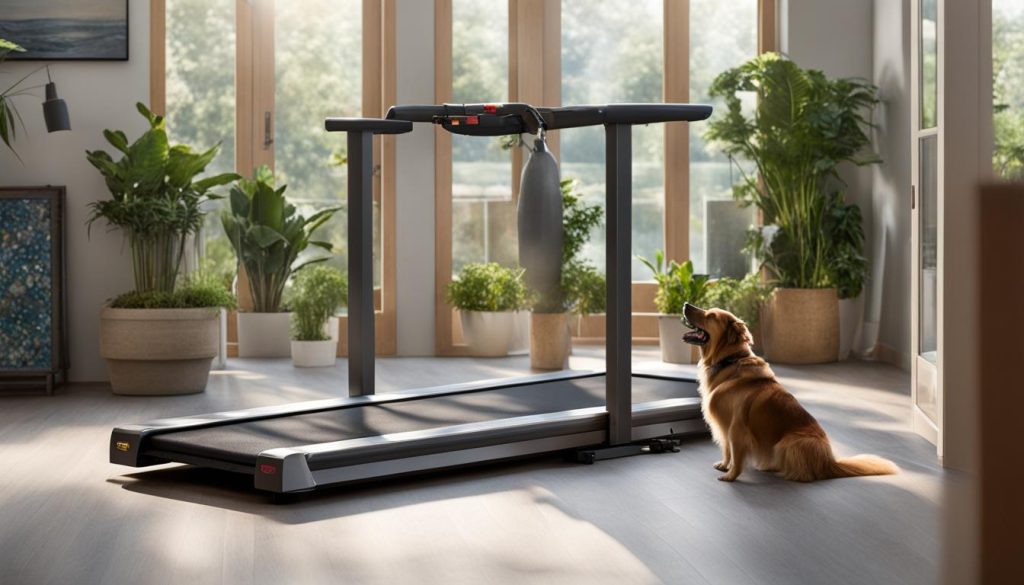
“Positive reinforcement is crucial in dog treadmill training. By using treats and praise, you can motivate your dog to use the treadmill and reinforce desired behaviors.”
I recommend that you remember that every dog is unique, and what works for one dog may not work for another. Some dogs may require more rewards and encouragement, while others may be content with simply using the treadmill. The goal is to make the training process enjoyable and rewarding for your dog, so be sure to tailor your approach to their individual needs.
Making the Treadmill a Fun Activity
In addition to treats and praise, there are other ways to make the treadmill a fun and engaging activity for your dog. Consider incorporating toys or interactive games into the training session. For example, you can place a favorite toy at the end of the treadmill to encourage your dog to walk towards it. This not only adds an element of fun but also serves as a mental stimulation for your furry friend.
Another way to make the treadmill more enjoyable is to vary the speed and incline settings. Dogs, like humans, can get bored with repetitive workouts. By changing the speed and incline, you can add variety and challenge to the training session, keeping your dog mentally and physically engaged.
Summary:
- Use positive reinforcement techniques such as treats and praise to make the treadmill a positive experience for your dog.
- Customize the rewards based on your dog’s individual preferences and adjust as needed.
- Incorporate toys and interactive games to make the training session more enjoyable.
- Vary the speed and incline settings to add variety and challenge to the workout.
Table: Tips for Making the Treadmill a Positive Experience
| Tip | Description |
|---|---|
| Use treats and praise | Reward your dog for getting on and walking on the treadmill |
| Customize rewards | Adjust the rewards based on your dog’s preferences |
| Incorporate toys and games | Add fun and mental stimulation to the training session |
| Vary speed and incline | Keep the workout engaging by changing the settings |
Differences Between Treadmill Exercise and Outdoor Walks
When it comes to exercising your dog, there are distinct differences between treadmill exercise and outdoor walks. Both options have their advantages and choose the right one based on your dog’s needs and the circumstances at hand.
Physical Demands
Treadmill exercise is more physically demanding for dogs compared to outdoor walks. When walking on a treadmill, there are no stops for sniffing and exploring, which means your dog will be engaged in continuous movement. This can be beneficial for dogs who require a higher level of physical activity for weight management or conditioning purposes.
Outdoor walks, on the other hand, offer dogs the opportunity to explore their surroundings, interact with nature, and engage in mental stimulation. It allows them to follow their natural instincts, such as sniffing, marking, and socializing with other dogs.
Weather Conditions and Convenience
Treadmill exercise provides a great alternative when outdoor walks are not possible due to extreme weather conditions, such as heavy rain, extreme heat, or cold temperatures. It allows you to maintain your dog’s exercise routine regardless of the weather, ensuring they stay active and healthy.
Having a treadmill at home also offers convenience, especially for busy pet parents who may not have enough time for long outdoor walks. It provides a quick and efficient way to provide exercise for your dog without leaving the house.
Balance and Variety
While treadmill exercise can be highly beneficial, balance it with outdoor walks to provide mental stimulation and allow your dog to experience the world beyond the treadmill. Outdoor walks allow your dog to engage their senses, explore new environments, and enjoy the social aspect of interacting with other dogs and humans.
By incorporating both treadmill exercise and outdoor walks into your dog’s routine, you can provide a well-rounded approach to their physical and mental well-being. This balance ensures that they receive the necessary exercise, mental stimulation, and socialization opportunities for a healthy and happy life.

| Treadmill Exercise | Outdoor Walks | |
|---|---|---|
| Physical Demands | Continuous movement, no stops for sniffing and exploring | Opportunity for sniffing, exploring, and interacting with the environment |
| Weather Conditions | Can be done indoors regardless of weather conditions | Dependent on weather conditions |
| Convenience | Allows for quick and efficient exercise at home | Requires time for outdoor walks |
| Balance and Variety | Should be balanced with outdoor walks for mental stimulation and socialization | Provides variety, mental stimulation, and socialization opportunities |
Choosing the Right Treadmill for Your Dog
When it comes to selecting a treadmill for your dog, there are a few important factors to consider. First and foremost, you’ll want to choose a treadmill that is the right size for your dog. Larger breeds may benefit from specialized dog treadmills that offer side panels for added stability, while smaller dogs can typically use regular treadmills. Ensuring a proper fit will allow your dog to exercise comfortably and safely.
Another key consideration is the features of the treadmill. Look for treadmills with adjustable incline control, as this will allow you to customize the intensity of your dog’s workout. Additionally, consider the length of the track to ensure that your dog has enough space to walk or run comfortably. If you have specific fitness goals for your dog, such as weight loss or endurance training, you may also want to look for treadmills with additional features such as preset workout programs.
It’s also important to check the condition of the treadmill before making a purchase. Ensure that there are no loose or broken parts that could pose a safety risk to your dog. If you’re using a human treadmill, you may need to remove the side panels to accommodate your dog’s size and comfort. Taking the time to choose a treadmill that meets your dog’s needs and is in good working order will help ensure a positive and effective exercise experience.
Table: Comparison of Dog Treadmill Options
| Treadmill | Size | Incline Control | Track Length | Additional Features |
|---|---|---|---|---|
| Standard Treadmill | Suitable for most dogs | Adjustable incline | Standard track length | N/A |
| Specialized Dog Treadmill | Designed for larger breeds | Adjustable incline | Extended track length | Side panels for stability |
| Fitness Treadmill | Dependent on size and weight capacity | Adjustable incline | Varies | Preset workout programs |
Choosing the right treadmill for your dog is an important step in ensuring their safety and comfort during exercise. Consider your dog’s size, the features of the treadmill, and the condition of the equipment before making a decision. With the right treadmill, you can provide your dog with a convenient and effective way to stay fit and healthy.

Familiarizing Your Dog with the Treadmill
Before starting the training process, you should familiarize your dog with the treadmill. This will help them feel more comfortable and confident when it comes time to use it. You can begin by introducing the treadmill to your dog while it is turned off. Allow them to sniff and explore the equipment at their own pace. Placing treats, water bowls, and toys near the treadmill can create a positive association and make it a more inviting space for your dog.
To further familiarize your dog with the treadmill, you can use verbal commands and treats to encourage them to walk on it while it is turned off. Start by standing next to the treadmill and asking your dog to step onto the stationary surface. Reward them with treats and praise when they follow the command. Repeat this process several times until your dog feels comfortable and confident standing on the treadmill.
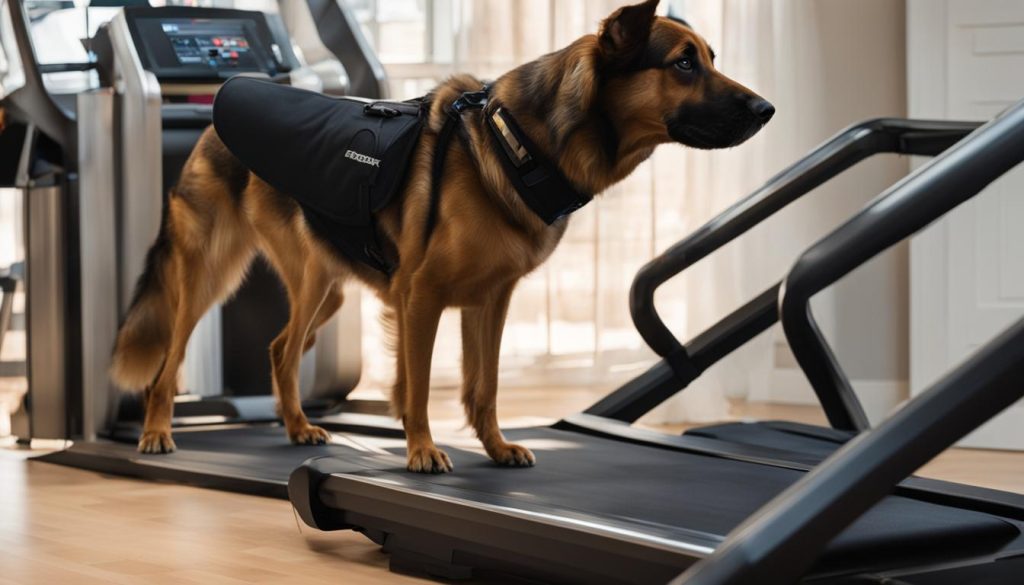
Introducing Your Dog to the Moving Treadmill
Once your dog is comfortable with the stationary treadmill, you can start introducing them to the moving equipment. Begin by setting the treadmill to the lowest speed and secure your dog’s leash. Encourage your dog to walk on the back of the treadmill with you. Use treats and verbal commands to reinforce the behavior and praise your dog when they step on the moving treadmill. Start with short sessions and gradually increase the duration as your dog becomes more comfortable.
| Benefits of Familiarizing Your Dog with the Treadmill | Steps to Familiarize Your Dog with the Treadmill |
|---|---|
|
|
By following these steps and providing positive reinforcement, you can help familiarize your dog with the treadmill and prepare them for successful training sessions. Try to always go at your dog’s pace and make the experience enjoyable for them.
Training Your Dog to Walk on the Treadmill
Training your dog to walk on the treadmill is a step-by-step process that requires patience and consistency. Here are the key steps to help you teach your dog to use a treadmill effectively:
- Introduce your dog to the treadmill while it’s turned off. Allow them to sniff and explore the equipment to create a positive association.
- Start with the lowest speed while keeping your dog leashed. Encourage your dog to walk on the back of the treadmill with you.
- Use treats and verbal commands to reinforce the behavior. Praise your dog when they step on the moving treadmill.
- Begin with short sessions and gradually increase the duration as your dog becomes more comfortable with the movement.
Try to make the training experience positive and rewarding for your dog. Use treats, praise, and consistent reinforcement to encourage their progress. Always monitor your dog’s comfort level and adjust the training accordingly. With time and practice, your dog will confidently walk on the treadmill and enjoy the physical and mental benefits of regular exercise.
| Steps | Description |
|---|---|
| 1 | Introduce the treadmill while it’s turned off to create a positive association. |
| 2 | Start with the lowest speed and encourage your dog to walk on the back of the treadmill with you. |
| 3 | Use treats and verbal commands to reinforce the behavior of stepping on the moving treadmill. |
| 4 | Gradually increase the duration of the sessions as your dog becomes more comfortable. |
Using Positive Reinforcement in Treadmill Training
Positive reinforcement is a crucial component of successful treadmill training for dogs. By using rewards and praise, you can motivate and encourage your dog to use the treadmill correctly. Dogs respond well to positive reinforcement as it creates a positive association with the desired behavior.
During treadmill training sessions, be sure to have a supply of treats readily available. Whenever your dog follows a command, such as stepping on the treadmill or walking on it, immediately reward them with a treat. This reinforces the behavior and lets them know they’re doing something right.
Try to use verbal cues and praise in conjunction with treats. By using consistent verbal cues, such as “treadmill” or “walk,” your dog will start to associate those words with the action of using the treadmill. Praise your dog enthusiastically when they successfully complete a treadmill session to further reinforce their positive experience.
Final Thoughts
Teaching your dog to use a treadmill is a valuable skill that can enhance their physical fitness and overall well-being. By following the step-by-step process outlined in this guide, you can ensure a positive and effective training experience for both you and your furry friend.
Try to start with creating a positive association with the treadmill and gradually introduce the sound and motion of the equipment. Reward your dog for their progress and always monitor their comfort level. Keep the training sessions short and enjoyable, allowing your dog to build confidence and enthusiasm for using the treadmill.
Using a treadmill for your dog’s exercise routine offers a range of benefits, including full-body workouts, rehabilitation support, and mental stimulation. I suggest, however, to balance treadmill exercise with outdoor walks to provide sensory experiences and mental enrichment.
By selecting the right treadmill for your dog’s size and needs, familiarizing them with the equipment, and incorporating positive reinforcement, you can create a rewarding and successful treadmill training journey. With patience, consistency, and the right approach, your dog will soon be walking confidently on the treadmill and reaping the physical and mental rewards of regular exercise.
FAQ
What are the benefits of using a treadmill for my dog’s exercise routine?
Using a treadmill for your dog’s exercise routine offers benefits such as providing a full-body workout, aiding in rehabilitation, warming up before training, and offering mental stimulation.
How do I introduce my dog to the treadmill?
To introduce your dog to the treadmill, start by creating a positive association, gradually introducing the sound and motion, and rewarding your dog for walking on it. Progress at a pace that suits your dog’s confidence and ability.
How should I train my dog on the treadmill?
Training your dog on the treadmill involves breaking the process down into manageable steps, starting with rewarding your dog for getting on the treadmill and gradually increasing the speed while rewarding them for walking on it. Keep the training sessions short and enjoyable.
How can I ensure the safety of my dog during treadmill training?
Safety is paramount during dog treadmill training. Never force your dog onto the treadmill or tie them to it. Always supervise your dog closely, be prepared to stop the machine if issues arise, and avoid over-exercising your dog. Use appropriate-sized treadmills to prevent strain or injury.
How can I make the treadmill a positive experience for my dog?
To make the treadmill a positive experience for your dog, use treats and praise to reinforce desired behaviors, continue treating or rewarding during workouts, and ensure the training sessions are enjoyable. The goal is for your dog to love using the treadmill.
What are the differences between treadmill exercise and outdoor walks?
Treadmill exercise is more physically demanding as there are no stops for sniffing and exploring. You should balance treadmill exercise with outdoor walks to provide mental stimulation and allow your dog to experience the world beyond the treadmill.
How do I choose the right treadmill for my dog?
When choosing a treadmill for your dog, consider their size and features. Use appropriately sized treadmills, and larger breeds may benefit from specialized dog treadmills. Check for any loose or broken parts and consider features based on your dog’s fitness goals and requirements.
How do I familiarize my dog with the treadmill?
Before starting the training process, allow your dog to become familiar with the treadmill. Introduce the treadmill while it’s turned off, let your dog sniff and explore it, and create a positive association by placing treats and toys near it.
How do I train my dog to walk on the treadmill?
Training your dog to walk on the treadmill involves starting with the lowest speed while leashed, encouraging your dog to walk on the back of the treadmill, using treats and verbal commands to reinforce behavior, and gradually increasing the duration as your dog becomes more comfortable.
How do I use positive reinforcement in treadmill training?
Positive reinforcement is key to successful treadmill training. Use treats and praise to reward your dog for using the treadmill correctly. Provide reinforcement immediately after following a command or stepping on the treadmill. Listen to your dog’s cues and adjust the training accordingly.


